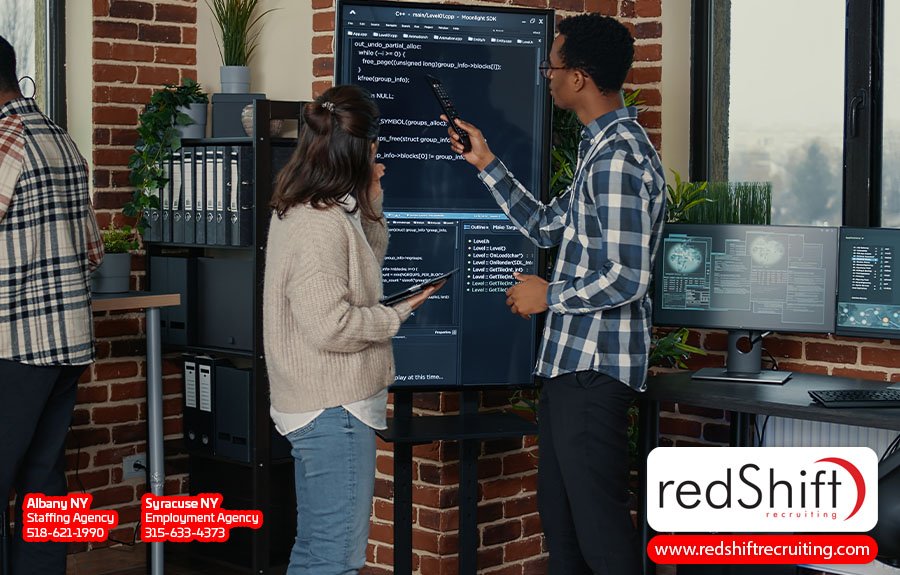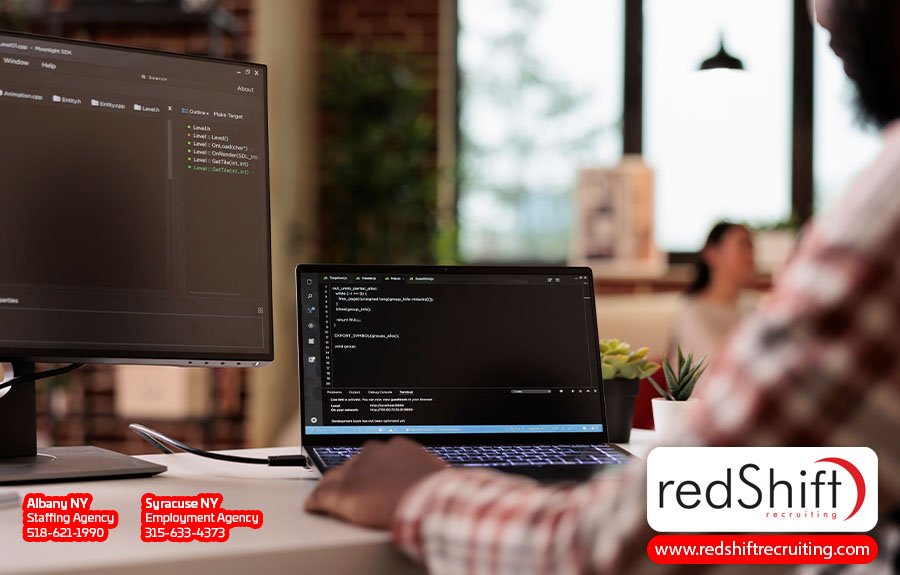The Fizzbuzz Test: What You Need To Know Before Your Next Programming Interview
Preparing for a programming job interview can be a daunting task, especially when it comes to technical tests like the FizzBuzz problem. The FizzBuzz Test is a widely used assessment tool that evaluates a developer's ability to write concise and effective code, comprehend fundamental programming concepts, and utilize programming logic to solve problems. To succeed during this section of the interview, it's important for job applicants to have a deep understanding of the test's purpose and structure, as well as how it is used to evaluate candidates. This article will guide you through the key aspects of this common programming challenge so you can confidently showcase your skillset and make a favorable impression on potential employers.
What Does Fizzbuzz Test?
The FizzBuzz test is believed to have been first introduced by "professional geek" Imran Ghory in 2007. Taking inspiration from the children's math game of the same name, fizzbuzz is designed as a practical assessment of a candidate's ability to write good code and solve a simple problem. The task involves writing code that prints out the numbers from one to one hundred, with certain exceptions. According to fizzbuzz rules, if the number is divisible by three, it should be replaced by "Fizz"; if the number is divisible by five, it should be replaced by "Buzz"; and if both conditions are met, the output should be "FizzBuzz." The fizzbuzz problem was designed to be used as a screening tool during coding interviews, enabling employers to quickly identify candidates who lack the necessary coding skills and knowledge to excel in software engineering roles.
Although the test seems simple and straightforward, some developers may struggle to tackle the problem in a stressful coding interview setting. To pass the FizzBuzz test successfully, candidates must have a solid understanding of key computer science concepts such as variables, control flow structures including loops and conditionals, data types, operators, and functions or methods. These concepts must be applied correctly and work in harmony to produce accurate results in the problem-solving process.
Moreover, good performance on this exercise also demands a strong understanding of problem-solving techniques such as breaking down complex problems into smaller subproblems that can be tackled individually. This demonstrates an aptitude for analytical thinking and creative solutions, which are highly sought-after qualities in today's software engineering industry.
How Does the Fizz Buzz Test Work?
The FizzBuzz test involves writing a function that prints out the numbers from 1 to 100, with certain modifications. For multiples of 3, it should print "Fizz" instead of the number, and for multiples of 5, it should print "Buzz." If the number is a multiple of both 3 and 5, then it should output "FizzBuzz." The goal is to write a program that can solve the fizzbuzz problem in as few lines of code as possible and without any syntax or logic errors.
In order to pass the FizzBuzz test, coding knowledge is required, as is an understanding of basic algorithms and data structures. Candidates must be able to construct efficient solutions while still adhering to best practices like producing readable code, avoiding unnecessary complexity, and minimizing computational costs. Knowing how different operations interact with each other will help them create more effective solutions when writing their fizzbuzz function.
How Difficult Is Fizzbuzz?
The Fizz Buzz Test can indeed be challenging for some programmers, especially those who are new to programming or are not familiar with the concept of the modulo operator. To solve the FizzBuzz problem, one needs to know how to use the modulo operator to check if a number is divisible by another number. Additionally, the programmer needs to print out the appropriate string for each case, which includes "fizz," "buzz," or "fizzbuzz." Most developers with a good foundation in coding should not find this test too challenging and will likely be able to solve fizzbuzz with relative ease. However, some entry-level candidates or those who do not have a strong understanding of basic coding principles such as loops and conditionals may find themselves struggling with this task. The level of difficulty in completing the FizzBuzz Test can also vary depending on the specific requirements or constraints given by the interviewer, and even some experienced developers may find it challenging to perform well under the pressure and time constraints of a high-stakes coding interview.
Ultimately, practice and patience can go a long way in helping you become comfortable with solving programming challenges like the FizzBuzz Test. Regular practice will help you improve your problem-solving skills and become better at writing efficient code. It is important to approach coding challenges like the FizzBuzz Test with a positive mindset and embrace the opportunity to learn and improve one's skills.
Why Do Employers Use the Fizzbuzz Test?
The Fizz Buzz test is a popular interview question designed to evaluate programming skills when interviewing people for jobs that require the ability to write code. It is designed as an efficient way to assess a person’s ability to write clean, working code in a concise and effective manner. This includes their control flow-related programming skills and their ability to use conditional statements and loops to manipulate program flow and generate the correct output based on a set of predefined rules. By using this test, employers can gauge the candidate's basic programming abilities and determine if they have the necessary skills for the job.
This type of technical evaluation offers recruiters insight into how well candidates are able to handle problem-solving tasks related to coding in their prospective positions. By presenting potential employees with the challenge of completing programming exercises during interviews, employers gain valuable information about their coding abilities, analytical skills, and coding style, as well as their ability to explain their reasoning, communicate technical concepts, and work effectively under pressure. This information is crucial to identifying qualified candidates and making better hiring decisions.
How Do You Beat Fizzbuzz Test Cases?
To beat Fizzbuzz test cases, it is important to understand the problem and approach it logically. Avoid brute-force solutions and optimize your code using computer science fundamentals such as algorithms and data structures. Writing good code is also important, and using whitespace and indentation will make it easier to read.
Preparing for Fizzbuzz questions in a job interview requires practicing your coding skills beforehand. This means writing code on paper or a white board, or using online tools to practice before attempting a live coding exercise. Understanding variables and control structures such as loops and if/else statements will also help you solve the problem more effectively. Keep in mind that while speed matters during interviews, accuracy is key when answering technical questions like this one.
During the interview, take the time to explain your thought process when developing your solution. This will help the interviewer understand how you approach problems and solve them. Even if you encounter errors along the way, being able to demonstrate your problem-solving abilities will bode well for you.
How Long Should Fizzbuzz Take?
The amount of time taken to complete this challenge varies depending on the individual candidate's coding skills and experience level. For a proficient programmer, the task should take no more than a few minutes to complete, since it is a relatively simple exercise that only requires basic programming knowledge. However, for someone who is new to programming, it may take longer to complete, depending on their level of experience and understanding of the fundamental concepts required to solve the problem. In an interview setting, employers typically expect candidates to complete the FizzBuzz test within five minutes or less to demonstrate their proficiency in basic programming concepts. An entry-level programmer may take a few minutes longer, but this should be a very short exam for anyone with basic coding skills.
Although it is important to complete the test within a reasonable time frame, accuracy should be prioritized over speed when faced with this popular computer science interview question. Understanding how to solve the problem logically and writing code that effectively and efficiently determines whether a given number is a multiple of three, five, or both is key to demonstrating strong programming skills. Simply printing out the correct outputs without clear explanations or an understanding of the code's workings is not enough to showcase proficiency in programming concepts. Therefore, it is crucial for candidates to focus on accuracy and clarity when tackling the FizzBuzz test in a coding interview.
Are There Any Variations of the Fizzbuzz Task?
The fizz buzz task asks candidates to think logically and write code for a simple problem, but there are other variations of this task used in coding interviews to test more advanced skills. One variation involves having the program output an empty string when no numbers are divisible by 3 or 5. This forces candidates to consider edge cases, such as 0 or negative numbers, which they may not have accounted for in their initial solution. Another version known as Ascending FizzBuzz or Sorted FizzBuzz requires that all the outputs be printed out in ascending order instead of printing them one at a time as each number is encountered. This allows employers to evaluate how well the programmer can structure their loops so that data is sorted correctly before it is displayed.
In the Reverse FizzBuzz variation, instead of counting up from 1 and replacing numbers divisible by 3 and 5 with "fizz" and "buzz," respectively, you count down from a specified number and replace the same numbers with "fizz" and "buzz." FizzBuzzWoof adds an additional requirement: instead of just replacing numbers divisible by 3 and 5, you also replace numbers that are divisible by 7 with "woof." So, for example, if a number is divisible by both 3 and 5, you would say "fizzbuzz," and if it's divisible by all three (3, 5, and 7), you would say "fizzbuzzwoof."
The FizzBuzzPlus variation gives candidates a list of divisors and replacement words, and you replace any number that is divisible by one of the divisors with the corresponding word. For example, if the divisors are 3 and 7, and the replacement words are "fizz" and "buzz," then a number divisible by 3 would be replaced with "fizz," and a number divisible by 7 would be replaced with "buzz." If a number is divisible by both 3 and 7, it would be replaced with "fizzbuzz." Another variation of this test is FizzBuzzBang. As with other variations, numbers divisible by 3 and 5 are replaced with "fizz" and "buzz," respectively, but numbers divisible by 7 are now replaced with "bang."
There are many other variations of the FizzBuzz task, and they can be adapted to suit different programming languages and skill levels. Some companies may use custom versions that require additional conditions and criteria beyond what is specified in the traditional FizzBuzz problem. These make it easier to extend the problem if needed while also testing more complex logic structures than those found in the standard challenge.
What Are Some Alternatives to Fizzbuzz?
There are many alternative programming problems that can be used instead of FizzBuzz to test a candidate's programming skills and problem-solving abilities. The following are a few examples:
Palindrome Checker: Write a program that checks whether a given string is a palindrome (reads the same backward as forward).
Anagram Checker: Write a program that checks whether two given strings are anagrams (contain the same letters in a different order).
Linked List: Write a program that implements a Linked List data structure.
Reverse a String: Write a program that reverses a given string.
Word Count: Write a program that counts the number of words in a given string.
Fibonacci Sequence: Write a program that generates the Fibonacci sequence up to a given number.
Sorting Algorithms: Write a program that implements different sorting algorithms, such as Bubble Sort, Insertion Sort, or Merge Sort.
Prime Number Generator: Write a program that generates a list of prime numbers up to a given number.
Caesar Cipher: Write a program that encodes and decodes messages using the Caesar Cipher.
Binary Search: Write a program that performs a binary search on a sorted list of numbers.
These are just a few examples of alternative programming problems that can be used to evaluate a candidate's programming skills and problem-solving abilities.
How Can You Prepare for the Fizzbuzz Test in Job Interviews?
Preparing for the FizzBuzz test in job interviews is essential to achieving success. The test can be stressful, as it requires the candidate to demonstrate their coding abilities quickly and accurately. It's important to adequately prepare for this test to build your confidence and maximize your chances of successfully landing the job.
For entry-level candidates or those unfamiliar with these tasks, an online tutorial or programming course will help you prepare. These resources help aspiring software engineers develop their skills and gain insight into the best type of approach for any given situation, in addition to practicing and developing good coding habits.
Practicing the problem is key. Familiarize yourself with the fizzbuzz rules and practice solving the problem on paper or a whiteboard before moving on to coding. Understanding alternative solutions or approaches to producing correct results can also be helpful in a stressful interview setting. Practice coding the solution, making sure you understand basic control structures such as loops and conditionals. Don't rush through your answer by guessing blindly. Focus on approaching the problem systematically and checking your calculations regularly to make sure you are returning accurate results before continuing on to the next number. Although the FizzBuzz problem may seem simple, many developers have fallen for the same trick of not paying attention to the order of their if-else statements or not properly handling edge cases. Don't forget to consider edge cases, such as negative numbers, zeros, and large numbers, and make sure your solution will also handle these cases correctly. Next, test your code with different inputs to make sure it produces the expected output. Fix any bugs or errors and optimize your code for performance and readability.
Try to replicate the environment of coding interviews. Many interviewers will ask candidates to solve the problem on a whiteboard or a piece of paper, so it's good to practice this way. You should also be prepared to explain your thought process and code while you're writing it out. Finally, set a time limit for yourself or try working in a distracting environment. This will help you prepare for the pressure and high stress of the interview and make you more confident in solving problems quickly and under stress. Through practice and repetition, you will develop confidence in your ability to choose an efficient solution for solving the problem correctly and quickly.
What Programming Languages Can Be Used to Solve the Fizzbuzz Task?
Programming job candidates can use several different programming languages to complete the fizz buzz coding challenge. Solving the task requires creative problem-solving abilities, which are essential for any successful programmer. There is no "best" programming language for this task, and any programming language that supports basic control structures such as loops and conditionals can be used to solve fizzbuzz. However, some languages may be better suited for certain aspects of this problem. For example, a language like Python, with its simple syntax and built-in range() function, may make it easier to write a concise FizzBuzz solution. On the other hand, a language like C++ may be well suited to optimize the solution's performance.
Java is another popular choice for its robustness and scalability capabilities. While Java does require more lines of code than most other languages, developers who know how to use its features effectively can write highly efficient programs suitable for solving problems like fizz buzz. Other options include Javascript, PHP, Kotlin, Ruby, R, and many others. Ultimately, the choice of programming language for solving FizzBuzz will depend on personal preference, familiarity with the language, and the specific requirements of the job or interview process.
Why Is Fizzbuzz Controversial?
Although Fizzbuzz remains a common test during coding interviews, it has sparked some controversy. Some believe this task is too simple for an experienced programmer. They argue it should only be failed by those unable to code their way out of a wet paper bag, and thus do not consider it a valid measure of programming ability. These critics argue that more complex and realistic problems should be used instead to better evaluate a candidate's ability to solve real-world problems.
On the other hand, some argue that the difficulty level should be set low because interviews can be stressful environments and applicants may not have enough time to solve more complex problems. Proponents argue that keeping it simple allows interviewers to still make sure that candidates have basic problem-solving skills without requiring them to showcase expertise in more advanced topics such as AI solutions.
Others argue against this type of test by pointing out that it may disproportionately disadvantage self-taught or non-traditional programmers who may not have encountered the problem before. Additionally, the pressure and stress of a job interview can create a challenging environment that may hinder even experienced programmers attempting to solve the problem within the given time constraints.
Despite these criticisms, many companies and interviewers still use FizzBuzz as a screening tool for candidates. The simplicity of the problem allows interviewers to quickly assess a candidate's basic programming skills and weed out candidates who may not have the necessary knowledge to move on to more complex programming tasks. They suggest that since most software development involves working with large amounts of numerical values, being able to manipulate these numbers accurately during an interview can show potential employers how reliable and detail-oriented the candidate is when dealing with code. For these reasons, many hiring managers maintain that the FizzBuzz test remains a useful tool for evaluating job seekers' capabilities.
Is It Possible to Fail a Job Interview if You Can't Solve the Fizzbuzz Task?
It is certainly possible to fail a job interview if you cannot solve the FizzBuzz task. However, it is important to note that the FizzBuzz problem is usually just one component of the interview process and is typically used as a basic screening tool to quickly assess a candidate's programming skills. While failing this task does not automatically disqualify an applicant, it could be interpreted as evidence of a lack of experience with or knowledge of basic coding concepts. Furthermore, it can also serve as an effective way to differentiate between applicants who possess similar qualifications on paper but differ in their technical capabilities.
In most cases, a candidate who cannot solve the FizzBuzz problem would be considered underqualified for the position they are applying for. However, there are exceptions to this rule, such as for junior or entry-level positions where the FizzBuzz problem may be seen as more of a learning opportunity than a strict requirement. Even in these situations, however, individuals who are able to efficiently solve the problem will likely gain a competitive advantage over those unable to do so.
While failing to solve the fizzbuzz problem may be a red flag for some employers, it is just one component of a comprehensive interview process. Interviewers will often consider factors beyond this test, including previous experience and soft skills such as communication, teamwork, and problem-solving abilities. Nevertheless, job seekers should familiarize themselves with the requirements for solving fizz buzz and practice completing this challenge prior to a coding interview.
What Do Employers Look for in a Fizzbuzz Solution?
When employers evaluate a candidate's FizzBuzz solution, they are looking for more than just the correct results. They want to see how the candidate approaches problem-solving and how quickly they can complete the task. Employers value candidates who understand programming fundamentals and use concise code that is easy to read and maintain.
In addition to providing a correct solution, employers will also consider the efficiency of the answer. This includes factors such as the speed of the code and the use of appropriate data structures and algorithms to solve the problem efficiently. The solution should also be well organized and easy to understand, including meaningful variable names and appropriate comments to clearly explain the code. A good solution should also account for edge cases such as negative numbers, zero, or other non-standard inputs. Finally, employers will use this test to identify programmers' coding style and knowledge of best practices. Solutions should follow best practices and adhere to coding standards such as consistent formatting, proper indentation, and the appropriate use of control structures.
Frequently Asked Questions
Is There a Time Limit for the Fizzbuzz Test?
The time limit for the FizzBuzz test can vary depending on the company or interviewer administering the test. In some cases, the interviewer may not set a strict time limit, while in other cases, they may expect the candidate to solve the problem within a certain timeframe. Since this is designed to be a relatively simple exercise, it is not uncommon for interviewers to expect candidates to be able to solve it within a few minutes. Even if the test has no set time limit, programmers should practice to be able to complete it within a reasonable amount of time.
Is It Possible to Use More Than One Programming Language for the Fizzbuzz Task?
It is possible to use more than one programming language when completing the fizz-buzz task. For example, some programmers may choose to use one language to write the solution and another to test it or display the results in a different way. Each language offers its own set of strengths and weaknesses, so while some may perform better on certain tasks, others may be more suitable for other operations. Some programming languages also allow for interoperability with other programming languages. In these cases, certain parts of the solution could be written in another language, where they are more easily implemented. Understanding which language will work best for their particular requirements as well as the implications and drawbacks of working with multiple languages on a single task will help programmers determine which approach is best for them.
Are There Any Specific Topics That Employers Expect Applicants to Know for the Fizzbuzz Test?
The fizz buzz test is designed to assess a candidate's understanding of fundamental programming concepts such as conditional statements, looping concepts, string manipulations, basic mathematical operations, algorithm design, and debugging techniques. Candidates must display strong analytical skills and the ability to use basic coding techniques and logical reasoning to solve problems. They should also be able to quickly identify errors in code and implement efficient solutions. Ultimately, employers who use fizz buzz are looking for individuals who understand the fundamentals of coding and computer science and can apply their understanding to developing quality software applications efficiently and accurately. Practicing these basic coding principles will give applicants the confidence to perform well during a coding interview as well as when tackling more advanced coding challenges that may arise during the assessment process.
Is It Necessary to Use a Certain Algorithm to Solve the Fizzbuzz Task?
There is no specific algorithm that is required to solve FizzBuzz. This problem is relatively straightforward, and there are many different ways to approach and solve it using various programming techniques and algorithms.
One of the most common approaches to solving FizzBuzz involves using a loop to iterate over a range of numbers and then using conditional statements to check each number and determine whether it should output "Fizz," "Buzz," "FizzBuzz," or the number itself. However, there are many variations of this basic approach, and other algorithms can also be used to solve the problem. Different programmers will approach the problem in different ways depending on their programming style, experience, and the specific programming language they are using.
What Tips Can You Give to Applicants to Help Them Succeed in the Fizzbuzz Test?
If you're preparing for a programming interview, chances are you may encounter the FizzBuzz test. To help you succeed in this common programming challenge, here are some tips to keep in mind.
Read and understand the problem statement: The first step in solving any programming problem is to carefully read and understand the problem statement. In the case of FizzBuzz, this means understanding the rules of the game and what the expected output should be. Note any formatting requirements to ensure that the solution meets all criteria specified in the problem statement.
Choose a programming language you are comfortable with: FizzBuzz is a basic programming test that can be solved in any programming language, so choose a language that you are familiar with and comfortable using.
Break down the problem into smaller parts: FizzBuzz can be broken down into smaller sub-problems, such as iterating over a range of numbers and checking each number for divisibility. By breaking the problem down into smaller parts, you can tackle each part individually and then combine them into a complete solution.
Test your solution: Before submitting your solution, test it thoroughly to ensure that it produces the expected output for a variety of inputs. This can help you catch any bugs or errors in your code and ensure that your solution is correct.
Write clean and well-structured code: Employers often look for candidates who write clean and well-structured code that is easy to read and maintain. Use descriptive variable names, add comments as appropriate, and follow good programming practices to make your code easy to understand.
Manage your time: Whether or not there is a time limit, interviewers will expect you to be able to complete this task in a reasonable amount of time, so you will need to be able to quickly assess what needs to be done and plan accordingly. Make sure you clearly understand the problem statement and requirements before starting, and don't spend too much time on any one aspect of the problem. Break down tasks into smaller components so each one can be tackled more efficiently, and anticipate common problems or errors that may arise. Your aim should be to complete the problem within a reasonable timeframe while still ensuring that your solution is correct and well-structured.
Be prepared to explain your solution: Finally, be prepared to explain your solution and answer any questions that the interviewer may have. This can help you demonstrate your understanding of programming concepts and show that you are capable of communicating your ideas clearly and effectively.
By following these tips, you can increase your chances of successfully passing the FizzBuzz test and demonstrating your programming skills and technical knowledge to potential employers.
Conclusion
The FizzBuzz test is a common programming challenge used by many employers to assess a candidate's fundamental programming skills. While it may seem simple, it's important to approach the problem methodically and with attention to detail. By following best practices related to coding languages and honing your knowledge of key programming concepts, you'll be well-prepared to ace your next FizzBuzz test and stand out during job interviews. Remember to take your time, test your solution thoroughly, and write clean and well-structured code. Good luck!
Article Author:
Ashley Meyer
Digital Marketing Strategist
Albany, NY






